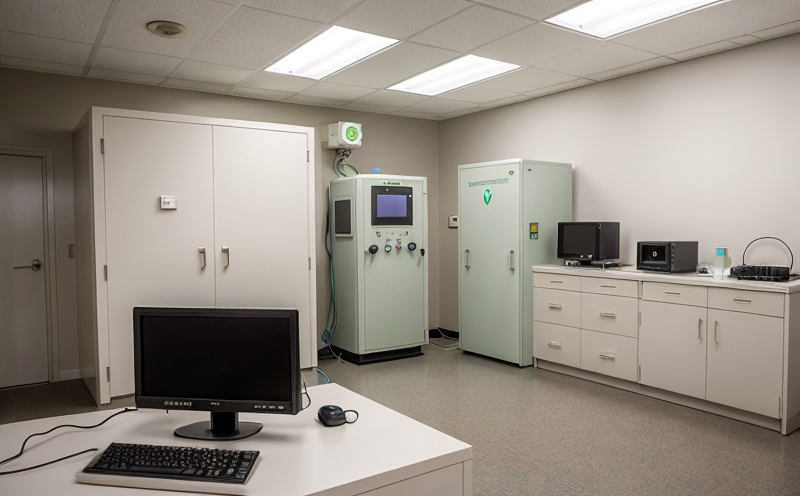ISO 29661 Reference Neutron Calibration Fields
The ISO 29661 standard defines reference neutron calibration fields which are essential for ensuring the accuracy and reliability of neutron dosimetry measurements. These calibrated fields serve as a benchmark against which other neutron sources can be compared, thereby enhancing confidence in dose assessment across various industrial sectors such as nuclear energy, healthcare, and research.
Neutron dosimetry is critical in environments where high-energy particles are present, necessitating precise measurement techniques to protect personnel and equipment. The reference fields specified by ISO 29661 provide a standardized method for calibrating neutron detectors, ensuring consistent and reproducible results. This standardization is particularly important in sectors like nuclear power plants, where accurate dosimetry is paramount for safety and regulatory compliance.
The calibration process involves exposing neutron detectors to known levels of neutron radiation, allowing them to be calibrated accurately against the reference fields defined by ISO 29661. This ensures that any subsequent measurements made using these calibrated instruments are reliable and traceable back to the international standard. The use of such standardized reference fields is crucial for maintaining consistent accuracy across different facilities and over time.
The primary advantage of adhering to this standard lies in its ability to provide a common reference point for neutron dosimetry. This facilitates better communication between various stakeholders, including regulatory bodies, researchers, and industrial operators. By ensuring that all measurements are made using calibrated instruments traceable to ISO 29661, the standard helps maintain consistency and reduces discrepancies in reported doses.
Furthermore, compliance with this international standard is often a requirement for obtaining necessary licenses or approvals from regulatory authorities. Organizations must demonstrate their adherence to such standards as part of their quality management systems to ensure they meet all legal requirements. This not only protects the organization but also enhances public trust by demonstrating commitment to safety and reliability.
The calibration process itself involves exposing neutron detectors to a series of reference fields that mimic real-world conditions. These fields are designed to cover a wide range of neutron energy spectra, ensuring that the detectors can be calibrated for various applications. The process typically includes precise measurement techniques using specialized equipment capable of detecting and analyzing neutron radiation at different energies.
Specimen preparation in this context involves creating test samples that accurately represent the conditions under which the neutron detectors will be used. These samples are then exposed to the reference fields according to strict protocols outlined in ISO 29661, ensuring that all measurements are made under controlled and consistent conditions.
Instrumentation plays a crucial role in this calibration process, with specialized equipment being used to measure neutron radiation accurately. This instrumentation must be regularly calibrated against the reference fields defined by ISO 29661 to ensure its reliability. The use of such advanced technology not only enhances the precision of measurements but also supports ongoing efforts to improve accuracy and reduce errors.
Reporting is another critical aspect of this service, with detailed reports being generated that document all aspects of the calibration process. These reports provide comprehensive information on the exposure conditions, detector performance, and any adjustments made during the calibration process. By providing thorough documentation, organizations can demonstrate their commitment to quality and compliance with international standards.
- Ensures precision in neutron dosimetry measurements
- Facilitates consistent results across different facilities
- Maintains traceability of all measurements to a common reference point
- Supports regulatory compliance and licensing requirements
Benefits
The benefits of using ISO 29661 Reference Neutron Calibration Fields extend beyond ensuring accurate measurements. By adhering to this international standard, organizations can enhance their reputation for reliability and safety, which is crucial in sectors where neutron radiation is involved.
One significant benefit is the ability to achieve precise and consistent dosimetry results across different facilities. This consistency is vital for maintaining operational efficiency and ensuring that all measurements are accurate and reliable. The use of standardized reference fields helps eliminate discrepancies in reported doses, leading to more confident decision-making.
The standard also facilitates better communication between various stakeholders involved in neutron dosimetry. By using a common reference point, organizations can ensure that all parties are working with the same level of accuracy and precision. This is particularly important in collaborative projects where multiple facilities or teams are involved.
Compliance with ISO 29661 is often a requirement for obtaining necessary licenses or approvals from regulatory authorities. By demonstrating their adherence to this standard, organizations can ensure that they meet all legal requirements and maintain compliance with international standards. This not only protects the organization but also enhances public trust by demonstrating commitment to safety and reliability.
Another benefit is the enhanced precision of neutron dosimetry measurements. The use of calibrated instruments traceable to ISO 29661 ensures that all measurements are made with high accuracy, reducing the risk of errors and improving overall quality. This increased precision is particularly important in critical applications where even small inaccuracies could have significant consequences.
Finally, by adhering to this international standard, organizations can enhance their reputation for reliability and safety. In sectors such as nuclear energy and healthcare, public trust is essential, and demonstrating commitment to high standards of measurement and calibration helps build that trust. This can lead to improved relationships with customers, partners, and regulatory bodies.





